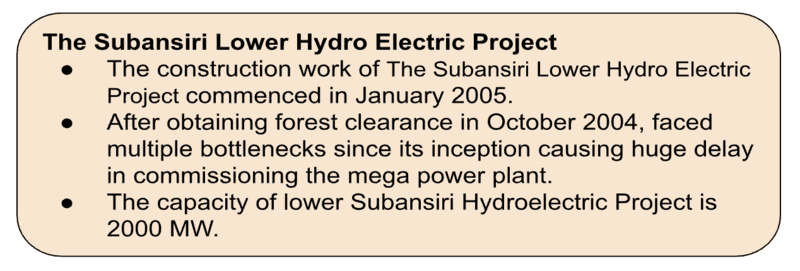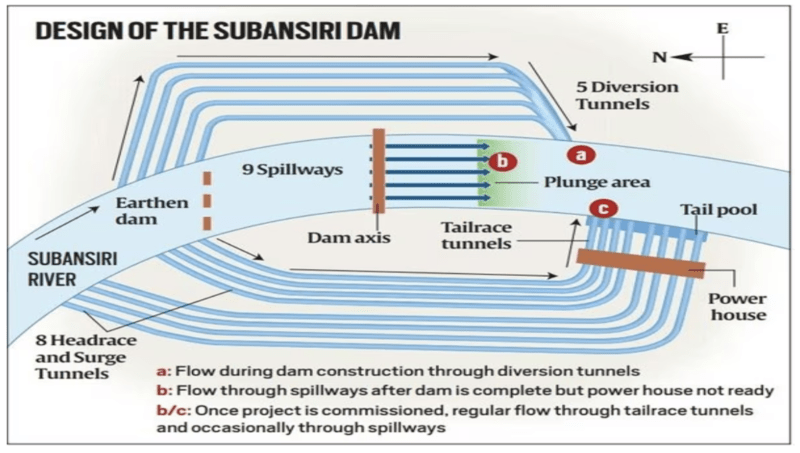GS Paper I & III
News Excerpt:
Recently, the flow downstream of Subansiri River was “highly reduced” - to an estimated 5-10 cubic metres per second (cumecs) - after a landslide blocked the only diversion tunnel in use.
Key points:
- On October 27, 2023, the long-delayed Subansiri Lower Hydroelectric Project on the border of Arunachal Pradesh and Assam suffered its latest setback after a large part of the hill on the left side of the dam collapsed into its reservoir.
- The deposits blocked the only functional diversion tunnel and stopped the flow of water downstream of the dam into the Subansiri River, a major tributary of the Brahmaputra.
- Construction of the project, which, when complete, will be India’s most prominent, began in 2005 but suffered a lengthy stoppage between December 2011 and September 2019 due to local opposition and significant changes in the dam's design.
- After work resumed, the deadline for commissioning the first two of the project’s eight 250-MW units has been extended five times: to March 2021, August 2022, March 2023, June 2023, and now March 2024.

How a dammed river flows:
- Typically, once a location is selected for a dam, a temporary earthen barrier (coffer dam) and a few diversion tunnels are built immediately upstream to bypass the dam construction site.
- Once the dam is ready, the diversion tunnels (DTs) are closed, and water starts to flow through the multiple spillways — gated holes in the dam wall that ensure regulated release.
- In a hydel project, tunnels are also built to carry water from the reservoir to the powerhouse. The water turns the turbines and then goes back into the river. Once the powerhouse is operational, this becomes the main path of the water, and the spillways are used occasionally.

The ‘mistake’ NHPC committed:
- The Central Electricity Authority (CEA), the statutory body that advises the government on policy relating to electricity systems, recommended in April 2022 that the impact of the DTs on the slope stability of the project site should be examined.
- NHPC Ltd, implementing the Subansiri Lower Project, ignored the recommendation. In April 2023, it said that “no more assessment of landslide hazards and their impact was needed” and that “necessary stabilisation measures have been carried out”.

Reasons for a landslide:
- Three main factors—geology, morphology, and human activity—are responsible for landslides.
- Geology describes the properties of the substance. It's possible that the rock or earth is brittle or weak or that the stiffness and strengths of the various layers vary.
- The structure of the land is referred to as morphology. For instance, landslides are more likely to occur on slopes that have lost their flora due to fire or drought.
- Construction and agriculture are examples of human activity that raises the possibility of a landslide.
- Rainfall, snowmelt, variations in water levels, stream erosion, variations in groundwater, earthquakes, volcanic activity, disturbance by human activity, or any combination of these events can cause landslides on slopes that are already about to move.
- Underwater landslides can also be caused by vibrations from earthquakes and other events.
Way forward:
- We cannot stop natural activities like earthquakes, and we cannot do anything for the geology or the structure of land, but we can stop such human activities that cause landslides.
- The government should provide proper clearance of any site before approval of any project so that landslides due to human activity can be reduced.
Prelims PYQ
Q. Which of the following is/are tributary/tributaries of Brahmaputra? (UPSC 2016)
1. Dibang
2. Kameng
3. Lohit
Select the correct answer using the codes given below:
(a) 1 only
(b) 2 and 3 only
(c) 1 and 3 only
(d) 1, 2 and 3


